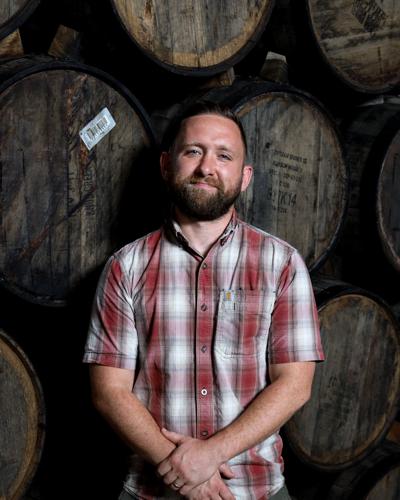Danny Childs recently won a James Beard Foundation award for his book “Slow Drinks.” It’s the culmination of experiences ranging from an anthropological trek studying botanical practices in South and Central America to farming in central New Jersey and tending bar at The Farm & Fisherman Tavern in Cherry Hill, New Jersey. His drinks use seasonal ingredients, and he also likes to make fermented beverages at home. Childs will attend Tales of the Cocktail, where he’ll participate on a panel on foraging and cocktails on Monday, July 22, and make drinks at a happy hour at Wild South on Tuesday, July 23. He’s also up for a Spirited Award for the book. For more on Tales of the Cocktail, visit talesofthecocktail.org. For more about Childs, see @slowdrinks on Instagram.
Gambit: How has the slow food movement affected your book?
Danny Childs: The title alludes to the slow food movement. I have worked closely with them for years. Metaphorically, it’s about using their “good, clean and fair” principles, as well as utilizing sustainability and biodiversity. On the literal “slow,” it’s a preservation book. It’s a beverage book that teaches you how to take raw ingredients and transform them through various preservation processes into liquid ingredients. It’s about following the calendar throughout the year using ingredients when they’re at their peak; using them fresh, but putting them up as well; using drinks as a way to tell the stories of the cultures that domesticated them, the ways they preserved them, and tying that back to mixology or the modern sense of how this fits into a drink in today’s cocktail scene.
Another part of slow is seasonality. Farming is an exercise in patience. I have an anthropological background, so it’s like another type of field work. I took that and translated it to the bar program I was running at Farm & Fisherman, which is very high volume. People always said we couldn’t do that at high volume. I always said we can do it at a high-volume bar in a strip mall in Cherry Hill, New Jersey, and you can do it anywhere. There’s a balance. There’s beverage service, the hospitality side, and then there’s the experiencing and using the bounty of the seasons and incorporating them into beverages.
Gambit: There’s also a lot of fermentation in the book, with beer, country wine, mead and more.
Childs: Early on in my career, I was like, I can’t just make syrups out of everything. What else can I do? That’s how I got down this path of different preservation techniques, but fermentation in particular. Those long-term projects don’t necessarily fit into bar programs.
A lot of that came from the pandemic and being holed up. I wasn’t leaving the house much and we had a new baby. At first it was messing around with what was out in back of the house. Then it became integrated into my yearly routine, starting with dandelion mead and spruce beer. I am having a banner blackberry season, so I am going to make some blackberry wine. My hops are coming in really nice, so I’ll probably make a proper beer this year. There are things that can’t be categorized as either beer or wine, which is why I say country wine. I do small batches of them all the time. They’re fun, but they’re for personal consumption, or to share with friends or on special occasions.
I have this fun game when I teach a class. I play “Will it ferment?” Nothing is off limits for me. There are things you don’t expect to find behind the bar. Sassafras root, chicory root, pine, ramps, dandelions. All kinds of funky stuff.
I did some tinkering for sure. I gravitated toward preservational master recipes. The tinkering for me was getting all these different books that weren’t professional brewing books. Hardcore brewers are intense on the rules and their ingredient proportions. I told this guy at a homebrew store that I was brewing a beer with honey and ginger bug yeast. He nearly laughed me out of the store.
Cousins Michael Vicari and Stephen Gambino take over Fausto’s.
Gambit: How has your approach to seasonal ingredients worked with drinks at the restaurant?
Childs: Lots of cocktail ingredients are unpalatable on their own, like a shot of gin. But gin is great in a martini or a bee’s knees cocktail or gin and tonic. When you’re making dandelion wine, it may seem intense by itself, but it could go in a dandelion gin and tonic. Like bitters or amaro. That’s what cocktails are as a whole: Mixed in harmony and balance with other flavor profiles, you can see the forest through the trees, so to speak.
At Farm & Fisherman, we’re doing esoteric things, but how do you make them relatable when the processes or ingredients are not? We all know what a sour cocktail, Manhattan or Negroni is. We’d start with that, and people would know what to expect. As a person trying to curate regulars and a crowd and people who want to see the menu change, we have to make this familiar to them.
We want this book to be applicable to people who aren’t professionals. It’s applicable to them as well, but I wanted people to be able to pick up this book and say this sounds good and I want to try that. I have dandelions in my yard and I want to try that.
What’s been the obsession of the food world for the last 10-15 years? It’s been ingredients from the local area, seasonality and process, especially fermentation. It makes perfect sense to extend these principles into the beverage world. I am seeing it the more I travel. It’s modern, but it’s ancient, too. These processes are age old. It gives people autonomy. It gets them excited about using things in their vicinity.
Elizabeth Williams told us about the museum's 20th anniversary and the recipes included in a new cookbook.




